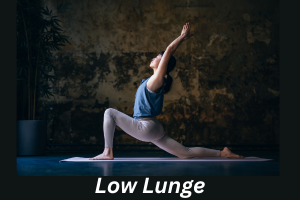Introduction
The Low Lunge Yoga Pose, or Anjaneyasana, is a fundamental yoga posture that provides a deep stretch to the hip flexors, quadriceps, and groin.
This pose not only enhances flexibility but also strengthens the legs, opens the hips, and improves balance.
Low Lunge is often incorporated into various yoga sequences, serving as a transitional pose between standing and seated positions.

Practicing the Low Lunge can cultivate a sense of grounding and stability, making it an excellent pose for both beginners and experienced practitioners.
As you explore this posture, you will not only experience physical benefits but also foster a deeper mind-body connection.
Steps to Perform Low Lunge Yoga Pose/Anjaneyasana
- Start in Downward-Facing Dog: Begin in Downward-Facing Dog (Adho Mukha Svanasana). Press your palms firmly into the mat, and lift your hips high, creating an inverted V shape with your body.
- Step Forward: Inhale and step your right foot forward between your hands. Ensure your right knee is directly above your right ankle, creating a right angle.
- Lower the Left Knee: Exhale and lower your left knee to the mat, allowing the top of your left foot to rest on the floor. Keep your right knee bent at a 90-degree angle.
- Align Your Torso: Inhale, lengthen your spine, and draw your torso upward. Keep your hips square and avoid letting your right knee extend past your ankle.
- Lift Your Arms (Optional): If comfortable, you can raise your arms overhead, reaching your fingertips towards the ceiling. Keep your shoulders relaxed and away from your ears.
- Engage Your Core: Draw your navel towards your spine to engage your core, promoting stability in the pose.
- Hold the Pose: Breathe deeply and hold the Low Lunge for 5-10 breaths. Feel the stretch in your hip flexors and quadriceps while maintaining a steady breath.
- Exit the Pose: To come out of the pose, exhale and lower your arms, then tuck your left toes under and step back into Downward-Facing Dog.
- Repeat on the Other Side: Step your left foot forward and repeat the steps on the opposite side.
Benefits of Low Lunge Yoga Pose/Anjaneyasana
- Stretches Hip Flexors: The Low Lunge deeply stretches the hip flexors, which can become tight due to prolonged sitting.
- Strengthens Legs: This pose strengthens the quadriceps, hamstrings, and gluteal muscles, promoting leg stability and endurance.
- Improves Flexibility: Regular practice enhances flexibility in the hips, thighs, and groin, making it easier to perform other yoga poses.
- Enhances Balance: The Low Lunge challenges your balance and coordination, improving your overall stability.
- Opens the Hips: This pose encourages hip opening, which is beneficial for activities such as running, dancing, and other physical sports.
- Promotes Mental Focus: Holding the pose requires concentration and mindfulness, fostering mental clarity and focus.
- Stimulates Digestive Organs: The gentle compression in the abdomen helps stimulate digestive organs, improving digestion and alleviating bloating.
Precautions and Contraindications for Low Lunge Yoga Pose/Anjaneyasana
- Knee Issues: Those with knee injuries or chronic pain should approach this pose cautiously. Use a cushion or folded blanket under the knee for extra support.
- Hip Problems: Individuals with hip injuries or conditions such as bursitis should consult a healthcare provider before practicing this pose.
- Back Pain: If you have chronic back pain, be mindful of your spine alignment and avoid excessive arching of the lower back.
- Pregnancy: Pregnant women should consult a healthcare provider before attempting this pose and may need to modify their practice accordingly.
- Recent Surgeries: If you are recovering from surgery, especially in the legs or hips, ensure that you have clearance from a healthcare professional before practicing Low Lunge.
- Headaches or Migraines: If you are experiencing headaches or migraines, it may be best to skip this pose, as it could exacerbate symptoms.
Conclusion
- The Low Lunge Yoga Pose is an essential part of many yoga practices, offering a blend of strength, flexibility, and balance.
- By incorporating this pose into your routine, you can enjoy numerous physical and mental benefits, enhancing your overall well-being.
- As you practice the Low Lunge, focus on your breath and alignment, allowing yourself to fully experience the sensations in your body.
- This pose can be a gateway to more advanced postures, providing a strong foundation for your yoga journey.
- Embrace the challenge of the Low Lunge and witness the transformation in both your body and mind.
